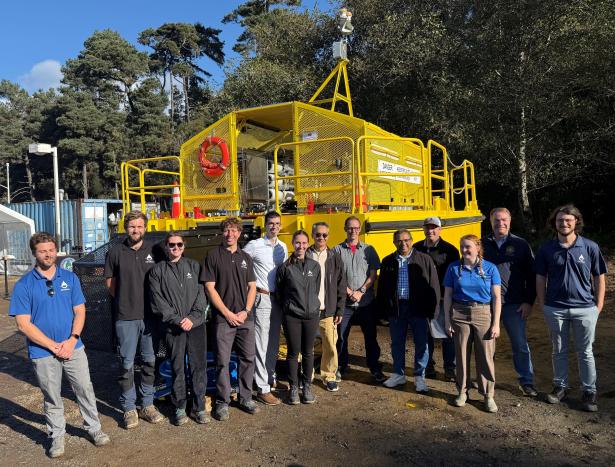 photo credit: Noah Abrams/KRCB
photo credit: Noah Abrams/KRCBThe Oneka Technologies team stands with the "iceberg", a floating ocean wave
powered powered desalination buoy. Oneka and the City of Fort Bragg unveiled the
recently arrived unit to local and state officials on 14 November, 2025.
State and regional elected officials are welcoming a piece of innovation to Fort Bragg that could be a savior for water scarce coastal communities.
After a long wait, Oneka Technology's wave powered desalination buoy is now resting in Fort Bragg.
With the nickname the "iceberg," the wave-powered desalination unit is 22 tons of bright yellow, solid metal, and it's getting ready for launch.
Dragan Tutic is the founder of the Quebec-based company.
"For Oneka, our mission is to make the oceans a sustainable and affordable source of drinking water," Tutic said at the unveiling ceremony. "The oceans are so abundant and they have a lot of energy from waves, so why not tap into it to create water for coastal regions in California."
The City of Fort Bragg has repeatedly faced water shortages, notably during drought years in 2014 and 2021.
The city uses between 700,000 to a million gallons of water daily. That dropped to around 637,000 gallons daily in 2021, as residents were forced to conserve water.
The scarcity has made city officials eager to diversify their freshwater sources. It's the big reason why they've partnered with Oneka to bring a desalination buoy to Mendocino.
How the desalination process works with the buoy is pretty simple. It gets anchored to the sea floor, Tutic says ideally on a sandy bottom to minimize impacts to reef banks, and once fixed in position, sea water is drawn in and filtered via reverse osmosis, Oneka engineer Vincent Blanchard explained, while standing atop the "iceberg".
"Basically with the wave action, just the buoyancy of the buoy kind of pulls on a rope that is tethered to the sea floor," Blanchard said. "As it comes up...the piston will be pushed inside. So that will suck in water, and also the [at] same time will pressurize the other side. So it's kind of a double action."
The buoy is still waiting on a final few regulatory hurdles before it can be towed out of Noyo Harbor and get tethered a half mile off the Mendocino coast. According to environmental documents, the system will be fixed with four primary anchor points on the sea floor between 150-250 below the surface.
The buoy is expected to filter around 13,000 gallons of fresh water a day, driven entirely by wave power, saving an estimated 50 tons of CO2 emissions during the year long pilot project.
The idea is to eventually deploy multiple buoys, in a kind of modular grid, to supplement the city's freshwater supply.
City officials said they are aiming to get a year-long pilot program started by the summer of 2026, with a focus on monitoring water quality and effects on the marine ecosystem from the wave-powered desalination unit.

 Live Radio
Live Radio




